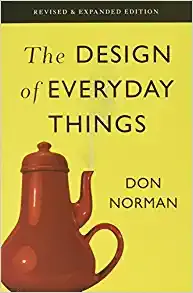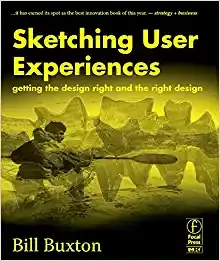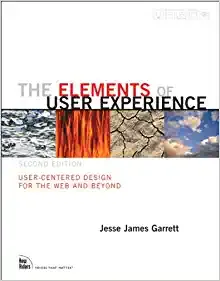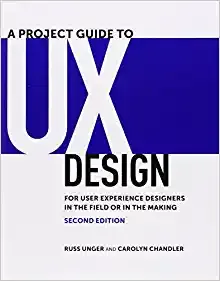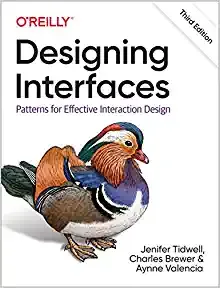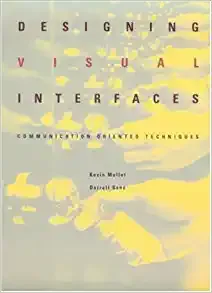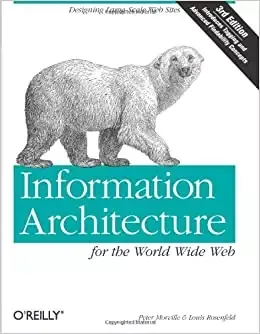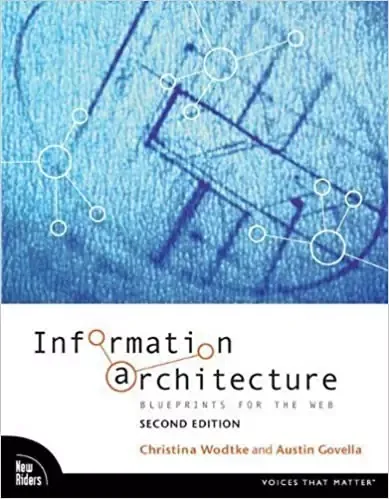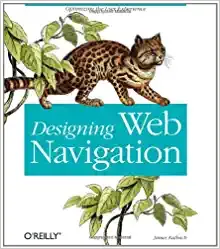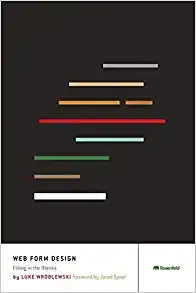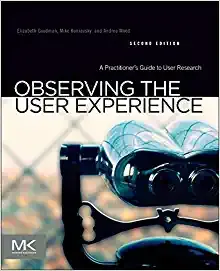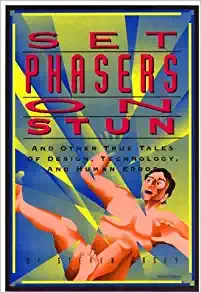A must-read for UX Beginners
1. The Design of Everyday Things
The Design of Everyday Things by Don Norman
There is a teapot on the cover of this book. The spout of the teapot is on the same side as the handle. If you pour tea, you are likely to burn yourself - Norman tells you that life is difficult, and it is often the fault of "bad design". To understand interaction, you must first understand people's needs for the design.
The development of industrial psychology has far exceeded that of the past. But it is still an unmissable read for designers, and no matter how the design concept develops, the steps of the year cannot be skipped. But don't think that the design ideas in the book are very advanced. Industrial psychology reading is too old and not recommended to read.
Even the smartest among us can feel inept as we fail to figure out which light switch or oven burner to turn on, or whether to push, pull, or slide a door. The fault, argues this ingenious—even liberating—book, lies not in ourselves, but in product design that ignores the needs of users and the principles of cognitive psychology.
The problems range from ambiguous and hidden controls to arbitrary relationships between controls and functions, coupled with a lack of feedback or other assistance and unreasonable demands on memorization. The Design of Everyday Things shows that good, usable design is possible.
The rules are simple: make things visible, exploit natural relationships that couple function and control, and make intelligent use of constraints. The goal: guide the user effortlessly to the right action on the right control at the right time.
In this entertaining and insightful analysis, cognitive scientist Donald A. Norman hails excellence of design as the most important key to regaining the competitive edge in influencing consumer behavior. Now fully expanded and updated, with a new introduction by the author, The Design of Everyday Things is a powerful primer on how—and why—some products satisfy customers while others only frustrate them.
2. Don't Make Me Think
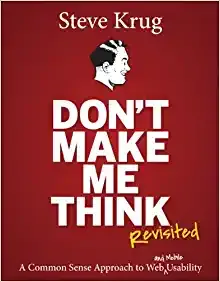
Don't Make Me Think, Revisited by Steve Krug
This book has been circulating in the industry for a long time, and everyone is looking forward to it. However, some friends say that many of the truths in the book are relatively trivial, or that we will consider them without the author's notification. I understand everyone's feelings, that is because they did not study the book while following the project.
Recently, I have been working on a project. The company leaders paid great attention to user experience issues. They especially looked for this book to learn, and combined it with the actual design work to verify some of the details mentioned in the book, and found that there are indeed many problems, especially in usability testing. It's worth adding to the project as it progresses. I learned more by doing and watching.
The author is actually a project manager. It can be seen that he is responsible for the user experience part of each website project every time. Therefore, from multiple projects, the author gradually realizes the psychology of everyone involved in the project in their respective positions. transformation.
In fact, the book seldom mentions the part specially designed for web designers. Many times it refers to the place of page layout and content arrangement. I think these are not only the scope that web designers consider but should involve product personnel. functions. The identity of the author should be that of a product person, not a designer.
Another feature of this book is that it pays attention to the details of page design, such as the website slogan mentioned in the article. The author also likes to assume that he is the designer of the website and designs a "revamped" page to illustrate his point of view.
This is a book that I discover every time I read it.
3. Sketching User Experiences
Sketching User Experiences: Getting the Design Right and the Right Design by Bill Buxton
Bill Buxton, a musician by birth, used computers in his artistic work more than three decades ago. He did research at the University of Toronto in the late 1970s, developing digital instruments, and boldly adopting novels The interface has since become famous, and has since held keynote positions at Xerox PARC, SGI, and Alias I Wavefront. Currently, Bill Buxton works at Microsoft and has become the backbone of research.
The content of the book is relatively rich, and the following points are absorbed after reading:
Wilderness Design: This is the point that really attracts me. Designing for the wilderness, designing for the user's real use environment, "must make every effort to fully understand the environment and social context in which it functions", rather than sitting in an office doing something out of the actual situation. Otherwise, the product will lack vitality.
The Cow Rule: This one really explains the software life cycle. Some of the books I read before only told me that there are several stages in the life cycle, and what strategies are used for the products in each stage. But as to why there are these stages, it is too general, as if a product is born with these stages.
In this book, Bill Buxton explains in detail why a software product, from the day it is released, has to work its way to the end. The fundamental reason lies in the continuous increase of its cost and the continuous shrinking of the target market. Four factors, such as complexity, user constraints, market saturation, and function scale, determine this trend.
These 4 factors are believed to be experienced by many people, but I have never thought about their relationship with the software life cycle. I can seem to see a piece of software being in constant contact with its surroundings from the day it is born. It finds its place, plays its role, and is also bound by its surroundings, and as it grows, it becomes more and more restricted, like dancing in chains.
Eventually, when its own growth can no longer bear the added burden, it reaches its turning point and begins to go downhill, slowly being replaced by something new. And this is the beginning of a new repetition.
This finally explains why Microsoft, Google, Apple, and other world-class companies, although a certain product has achieved world-renowned achievements, spare no effort and can't wait to continuously launch new products. It turns out that this is determined by the law of the development of the product itself. Prosperity and decline also remind me of Einstein's saying: "Life is like riding a bicycle, if you want to keep your balance, you have to move forward".
Freehand sketch: In the initial stage of design, a freehand sketch is an important tool for expressing ideas. After reading it, I had the urge to learn hand painting. However, the author also showed that his hand-painting skills are not very good (if not as good as mine), but he used some other tricks to solve this problem.
State transition diagram: A collection of interface diagrams, flowcharts, and numbers, that can clearly display the composition of the page and its position in the process. It is a good tool and you can try it out.
Moleskine Notebook: After seeing this, I realized that there really is such a well-designed notebook in the world. I have always felt that the notebook around me is important and practical, but it is too simple, and there is always a feeling that it is lacking.
4. Emotional Design
Emotional Design: Why We Love (or Hate) Everyday Things by Don Norman
The most important concept in the book "Emotional Design" is to divide the design goals into three levels, namely instinct level design, behavior level design, and reflection level design.
This is not the author's founding theory but corresponds to psychology: the human brain has three different levels of processing: instinctual, behavioral, and reflective. So this book does not provide a methodology but uses the theory of psychology to explain the phenomenon to us: how product design combines these three levels, that's all.
This book is suitable for beginners to read. On an instinctive level, I think the paper is good and the layout is beautiful. From a behavioral perspective, there is some thought-provoking content, but limited. Far less than Cooper's "Essence of Interaction Design". From a reflection level, I also choose Cooper, because he is the originator of interaction design.
Using an existing theory to explain everyday phenomena is no more difficult than extracting a theory from the phenomenon. The author cleverly used this theory to explain the field of product design, which attracted a lot of attention. The conclusive thing is very simple, and it is too cumbersome and wordy if it expands too much.
So the man above said: "He can turn a sentence over and over and use about 50 pages of paper to say a sentence, and it's really good."
This is a book that can be flipped through. After flipping, there is no need to save it. It can be sent to friends to avoid repeated purchases and waste.
Of course, it has a good ideological enlightenment effect for some beginners or upper management. From this perspective, it is also a good book, which is conducive to the popularization of the concept of "interaction design". This will help you to carry out your daily work in the future. Hehe, compared with this benefit, the cost is still very cheap.
It would be even better if the book could be published in a concise manner in the form of a succinct dissertation.
Advanced Reading
1. The Elements of User Experience
The Elements of User Experience: User-Centered Design for the Web and Beyond by Jesse James Garrett
This is what the famous Ajax father wrote to illustrate his famous "The Elements of User Experience" layered diagram. I just got it in my hands, and I read it at will. Everyone feels that it is not worth reading the familiar content and sparse text. In order to have a clearer understanding of the elements proposed by Garrett, I read it patiently.
As a result, during the reading process, I found that the problems and solutions faced by the user-centered design process are mentioned in many places in the text. If Saying Usability Engineering is the first book in the usability field, then I recommend this book as a second must-read.
From the title of the book, I thought it would explain the elements of user experience, such as emotionality, pleasure, branding, ease of use, etc. However, this book is explained from a user experience project, through the strategic layer, The five-layer decomposition of the scope layer, structure layer, framework layer, and presentation layer illustrates the process of user experience work from coarse to fine.
In the text, the author constantly emphasizes the significance of the strategic layer, that is, the user experience goals and values of the product must be clearly defined, and a clear explanation of interaction design and information architecture is given.
At the same time, it mentioned a lot of problems that may be encountered in the process of user experience design, such as insufficient time, the difficulty for users to find, and how to carry out work when the test cost is too high. Although there are many difficulties and problems, the author said them very well. Well, in the process, "the last mistake we should make is to perfunctory UX work with the interface of saving project time and money."
2. About Face
About Face: The Essentials of Interaction Design by Alan Cooper
Friends of interaction design and interface design should read this book. Friends who do program development should also read this book.
I read this book in the company. I set aside about two hours at work every day, put it aside when I was busy at work, and read it off and on.
When I first read it, I didn't think it had any good feelings but felt a little boring and weak. However, as the page is turned, it will attract you more and more, not the beauty of the text, not the advanced technical knowledge, but by showing you what interaction is section by section - I can't say yes to All people, but I do know what is called "interaction" from here, what is called "interface design".
It made me realize that software has a kind of "life", and when we use software, we are in a "dialogue" with software. It should be a "multifaceted social hand" who is advanced, intelligent, and good at understanding people.
Domestic software companies hired an artist and started "interface design". You can't doubt the power of the artist. They really put the software into beautiful frames, and all the power is put into our "eyes". The main strength of the software company is the programmer's "code programming", which uses advanced technology to write paragraphs of exquisite "functions". But what do you get when you put it on the market? A machine that is too advanced for a machine to be used on-demand.
After reading this book, and then looking back at the program you wrote, you will no longer complain about why the testers found so many bugs for me. My software is already very powerful, so why are customers dissatisfied?
It's not that others are too picky, but we are too lack "interaction", software should be built on the basis of people-oriented, another way of thinking if it is a human who is talking to you and communicating with you...
3. A Project Guide to UX Design
A Project Guide to UX Design: For user experience designers in the field or in the making by Russ Unger
I feel that most of the domestic companies that make websites still lack UX positions, either as designers or as project managers and account managers.
If the commercial promotion website can make do, I am afraid that there is no shortage of people who really do UX in the application category, especially mobile products. Therefore, the functions need to be more subdivided, and someone needs to study and implement them specially.
This second edition joins several new trends that the industry cares most about: Responsive Design (including Mobile First), Content Strategy, and Lean UX. At the same time, combined with the decision-making ideas in project management, I feel that after reading it, I will not only sort out the current UX design process but also improve the control of a complete project.
Design principles
1. Designing For The Social Web
Designing For The Social Web by Joshua Porter
The book begins with one thing clear: the socialization of the web and software is an extension of the socialization of people. This is also an eternal basic principle in today's social products. Each of us is both an independent individual and a member of a group social environment. Therefore, social products must not only satisfy individuality but also support the society in which they live. Interaction needs of environment and people.
The AOF design framework in Chapter 2 is also very classic. Activities (Activity), interactive objects (Object), and core functions (Feature) together build the infrastructure of social software. All SNS products are designed around these three points. ; The third chapter mainly talks about the concept of treating users with sincerity, the importance of community management and customer service;
and then describes several key points in product design through several thresholds:
Threshold 1: Interested in using, that is the Design registration process
threshold 2: From first use to daily use, that is, to design a model that continuously motivates users, and identify how to motivate users from their core motivations.
Chapter 6 discusses the importance of crowd intelligence design, that is, user participation in design. From user behavior, integrated display, and feedback, such as a closed-loop, by designing many leverage points, a complex adaptive system is built, so that the system can adapt to a high degree of refining the user's wisdom and continuously improve the product.
Chapter 7 talks about sharing design. In today's mobile Internet products, sharing is simpler, but it is also necessary to analyze the motivation behind sharing and the changes in user psychology during the sharing process.
The last chapter introduces the funnel analysis method. This method is not only suitable for social products but also for other products such as e-commerce. It uses data to identify user behavior and find out the improvement points of products. Of course, don’t be blinded by data. Data cannot be completely trusted. real user behavior. This chapter also introduces some other data indicators, such as the residence time of PV UV repeated visits, etc., which are indicators that can be referenced for data operation.
The article as a whole is easy to understand, and the examples are very vivid. Looking at the product design method nearly ten years ago from today's perspective, some core things have not changed.
2. Designing Interfaces
Designing Interfaces: Patterns for Effective Interaction Design by Jenifer Tidwell
This is an introductory book on interaction design. Author Jenifer Tidwell shows readers how to design better interactive systems in the way of design patterns.
When a team with incomplete members is developing a new product, the following two situations often occur:
1. The graphic designer is the center. A common situation is to develop a Web site, the designer and the customer discuss the needs, cut the picture to be made, and then hand it over to the programmer to add the background program. The programmer only cares about writing the program well and making the pictures handed to him alive by the artist.
2. Programmer-centric. This general situation is a more complex application, and the customer cares more about whether the programmer can achieve the function he expects. The programmer first realizes the function of the implementation according to the template given by the artist and then returns it to the artist. The artist adds some decorations and beautifies them according to the existing procedures.
In the second case, handing the interaction design to the programmer is a terrible situation. Programmers can only speculate on the user's mind based on experience. But this interaction design experience is just the experience of feeling the interaction as a programmer, so it was wrong from the start.
What I advocate is to involve interaction designers in the design and development of programs. Product managers should clearly know that to make a product more viable, it is not only the use of advanced technology to achieve the functions required by customers but also the user experience of the product.
Of course, if you are a programmer, and your product manager doesn't realize the importance of user experience, but you have a sense of responsibility to make the product well, this "Designing Interfaces" is perfect for you.
3. Designing Visual Interfaces
Designing Visual Interfaces: Communication Oriented Techniques by Kevin Mullet
Ironically, many designers of graphical user interfaces are not always aware of the fundamental design rules and techniques that are applied routinely by other practitioners of communication-oriented visual design -- techniques that can be used to enhance the visual quality of GUIs, data displays, and multimedia documents.
This volume focuses on design rules and techniques that are drawn from the rational, functionalist design aesthetic seen in modern graphic design, industrial design, interior design, and architecture -- and applies them to various graphical user interface problems experienced in commercial software development.
Describes the basic design principles (the what and why), common errors, and practical step-by-step techniques (the how) in each of six major areas: elegance and simplicity; scale, contrast, and proportion; organization and visual structure; module and program; image and representation; and style.
Focuses on techniques that will not only improve the aesthetics of the visual display, but, because they promote visual organization, clarity, and conciseness, will also enhance the usability of the product. Includes a catalog of common errors drawn from existing GUI applications and environments to illustrate practices that should be avoided in developing applications.
For anyone responsible for designing, specifying, implementing, documenting, or managing the visual appearance of computer-based information displays.
4. Information Architecture for the World Wide Web
Information Architecture for the World Wide Web: Designing Large-Scale Web Sites by Peter Morville and Louis Rosenfeld
I have been in the business for some time, and I have seen many documents and designs. In the draft, part of it is a description of the "information architecture". These descriptions are generally just a sitemap of a website or even the most cursory descriptions of navigation and page relationships - is this just a very small part of the information architecture? What exactly is information architecture?
After reading "Web Information Architecture", which I have been squatting in the "Want to read" list for a long time, I feel a little relieved, as if my long-standing procrastination has improved a little. One of the great advantages of reading the electronic version is that you don't feel the thickness of the book. You read, read, read, and suddenly you find that you're finished.
Closer to home, this is a "rigorous" and "passionate" book. The rigorous part really introduces the basic concepts, methods, cases, etc. of information architecture; the enthusiastic part is simply the bonus of this book, as an emerging, interdisciplinary field where the value is to be proved, the author uses his rich experience and a ramble and humorous tone to tell us what challenges this industry faces, what people at what levels of the organization, what challenges and what kind of challenges will be raised.
Questions, as a reliable information architect, what kind of attitude should be used to face and answer these questions. —Really, don’t talk about information architecture.
5. Information Architecture: Blueprints for the Web
Information Architecture: Blueprints for the Web by Christina Wodtke and Austin Govella
I am used to reading technical books in black and white, so reading the colorful "Splendid Blueprint" is naturally more pleasing to the eye, and it is a great pleasure to be able to enjoy the eye while learning the technology! The two sample articles complement each other and both left a deep impression on me.
First look at the second chapter, its title is "Balance Law of Users, Technology, and Enterprise", several irregular stones on the color map are stacked vertically together, forming a kind of balance, which just matches the meaning of the title. Different stones can be regarded as having different roles in the whole architecture, such as users outside the enterprise, market researchers, marketers, programmers who write back-end programs, and programmers who are responsible for front-end development.
And artists, cooperate, cooperate with each other, and create a balance in the work process. Then the author elaborates on the three aspects of users, enterprises, and materials, but I personally feel that the content after 2.4 is not closely related to the title of Chapter 2, and it may be more appropriate to put it in other chapters that describe the organization of materials.
Let’s look at the fourth chapter. Its title is “Information Architecture in the Eyes of Bricklayers”. With the pictures and the small words on the side of the title, it expresses “The wood that hugs is born at the end of the thread; the platform of nine layers starts from the earth.” This timeless truth.
Website architecture, no matter how huge and complex it ends up being must be a combination of different types of small data. From this, the author introduces the topic of metadata and divides the metadata into three types to describe according to its nature—inherent metadata, descriptive metadata, and managing metadata. Organization and division of metadata.
In the process of reading this chapter, the expression "controlled vocabulary" has always made me feel a little awkward. My understanding of this is synonyms, but whether the author uses this word has other deeper meanings, is really unclear. know.
In short, after reading the sample chapter, I feel quite rewarded, and personally think this is a good book worth reading.
6. Designing Web Navigation
Designing Web Navigation: Optimizing the User Experience by James Kalbach
Thoroughly rewritten for today's web environment, this bestselling book offers a fresh look at a fundamental topic of website development: navigation design. Amid all the changes to the Web in the past decade, and all the hype about Web 2.0 and various "rich" interactive technologies, the basic problems of creating a good web navigation system remain.
Designing Web Navigation demonstrates that good navigation is not about technology-it's about the ways people find information, and how you guide them.
Ideal for beginning to intermediate web designers, managers, other non-designers, and web development pros looking for another perspective, Designing Web Navigation offers basic design principles, development techniques, and practical advice, with real-world examples and essential concepts seamlessly folded in.
How does your website serve your business objectives? How does it meet a user's needs? You'll learn that navigation design touches most other aspects of website development.
This book:
- Provides the foundations of web navigation and offers a framework for navigation design
- Paints a broad picture of web navigation and basic human information behavior
- Demonstrates how navigation reflects the brand and affects site credibility
- Helps you understand the problem you're trying to solve before you set out to design
- Thoroughly reviews the mechanisms and different types of navigation
- Explores "information scent" and "information shape"
- Explains "persuasive" architecture and other design concepts
- Covers special contexts, such as navigation design for web applications
- Includes an entire chapter on tagging
While Designing Web Navigation focuses on creating navigation systems for large, information-rich sites serving a business purpose, the principles and techniques in the book also apply to small sites. Well-researched and cited, this book serves as an excellent reference on the topic, as well as a superb teaching guide. Each chapter ends with suggested reading and a set of questions that offer exercises for experiencing the concepts in action.
7. Web Form Design
Web Form Design: Filling in the Blanks by Luke Wroblewski
Interaction is an indispensable key to Internet products, and the entry point of interaction must be a form.
Practice alone is not enough, we have to point out the common things behind the scenes that support these practices so that readers can draw inferences from one case to another.
I have learned a lot from reading the whole book, and looking at the summaries of predecessors can really save a lot of effort in trying and groping.
I have learned a lot, and the deep impression is that the author did not directly give a conclusion on which design is better, but through the experimental results and analysis, showed the advantages and disadvantages of different designs, and finally came to a specific analysis of specific things. in conclusion.
In fact, after reading it, it is still inseparable from your own attempts, don't stand still, there may be better ways. Perhaps this is the book's greatest revelation?
Action Guidelines
1. Usability Engineering
Usability Engineering by Jakob Nielsen
This book is a systematic introduction to usability engineering and has been unanimously praised by the international usability engineering community as the best introductory book in this field.
"Usability Engineering" systematically introduces usability engineering, and is unanimously praised by the international usability engineering community as the best introductory book in this field. Usability Engineering focuses on cost-effective usability methods and details how to apply these methods at different stages of the software development life cycle, as well as other specific usability-related issues.
This book is an excellent guide to the methods of usability engineering. The book provides the tools needed to avoid usability surprises and improve product quality. Step-by-step information on which method to use at various stages during the development lifecycle is included, along with detailed information on how to run a usability test and the unique issues relating to international usability.
2. Handbook of Usability Testing
Handbook of Usability Testing: How to Plan, Design, and Conduct Effective Tests by Jeffrey Rubin
This book talks more about methodology is more thought-provoking and is the best-advanced reading for beginner designers.
Whether it's software, a cell phone, or a refrigerator, your customer wants - no, expects - your product to be easy to use. This fully revised handbook provides clear, step-by-step guidelines to help you test your product for usability. Completely updated with current industry best practices, it can give you that all-
important marketplace advantage: products that perform the way users expect. You'll learn to recognize factors that limit usability, decide where testing should occur, set up a test plan to assess goals for your product's usability, and more.
3. Observing the User Experience
Observing the User Experience: A Practitioner's Guide to User Research by Mike Kuniavsky
This book was not very thick. At first, I felt that it was not as difficult as "About-face 3. The essence of interaction design", but after reading it, it seemed like a layer of skin was peeled off...
Yes, if you are a rookie in user research, this book is still OK, such a hard-working author really Not much. When I talked about methods and tools in the second article, I could not wait to record every paragraph and every sentence, and finally made the longest reading note in recent times.
However, there are still some problems. For example, according to the author’s own words, the things discussed in each chapter of the second chapter are not all in parallel. For example, recruitment and interviews must be discussed separately because they are too important, but they are not a user research method in themselves. What about the other chapters that are not typical user research methods?
The author didn't make it clear, and I was at a loss. For example, after reading the whole book, I feel that I know how to conduct situational research, focus groups, usability testing, etc., but I still don’t know which method is the best to use when I want to obtain what information.
The author does say at the beginning of each method, the timing of using the method, but the conclusion is always in the early stage of the development cycle, which makes people puzzled; if it is more humane, it can also be used in the second article. A summary is made in tabular form at the end to make the relationship between the methods clear to the reader.
In addition, after reading this book, if you think about the application and research methods in the book from a global perspective, you will have a feeling of facing the "wheel". It is obviously some primitive and not-so-clever method, but since scientists have no good substitutes, everyone can only use them for the time being. To collect information is to conduct interviews or observe the completion of tasks and record them.
However, the information is too cluttered to be directly analyzed. Therefore, when analyzing data, we first group them. Whether it is data coding or card analysis, this behavior is just a different name. When grouping, it is also required to be divided according to the natural feeling. I really don’t understand this.
If the name or label of the group is according to the natural feeling, it will definitely be difficult to maintain independence from each other, and it will be difficult to group a large number of elements. Plus, with several people working in groups, it can be difficult to articulate the exact meaning of the tags you name. After the grouping, according to the method in the book, it seems that the end is near, and the desired information is basically clear. I really disagree.
Document class
1. Communicating Design
Communicating Design: Developing Web Site Documentation for Design and Planning by Dan M. Brown
This book has two parts: Design Diagrams and design deliverables. This classification itself is interesting and reveals how many discussions and thoughts are behind it.
The two parts cover:
- Design Diagrams: Personas, Concept Models, Site Maps, Flowcharts, and Wireframes. Each of these is a separate, stand-alone diagram that needs a document around it to provide context.
- Design Deliverables: Design Briefs, Competitive Reviews, Usability Plans, and Usability Reports. These are multi-page documents that tell extended stories, incorporating diagrams from the first part of the book.
The book goes into detail about each artifact, including anatomy, and tips on creating and presenting. I enjoy the clear definition and supportive visuals given for each artifact, for example:
A site map is a visual representation of the relationships between different pages on a website. Also known as a structural model, taxonomy, hierarchy, navigation model, or site structure.
When creating, I now learn the lesson: create for your audience, and avoid being self-indulgent.
The greatest misuse of a document is to create it for its own sake, and not to ensure its contribution and value to your project, your team, or the end product.
When presenting, Dan recommends a basic flow that can be applied and adapted for all kinds of artifacts:
- Establish context
- Describe visual conventions
- Highlight major design decisions
- Offer rationale and identify constraints
- Point out details
- Communicate implications
- Solicit feedback
- Provide a framework for review
I find this flow helpful to reflect on my own work, especially how to think ahead of the potential risks of the design solution and communicate clearly the implications to stakeholders, and how to better plan for feedback or “homework” part (review after the meeting).
2. Set Phasers on Stun
Set Phasers on Stun: And Other True Tales of Design, Technology, and Human Error by S. M. Casey
A disturbing share of technological disasters is caused by incompatibilities between the way things are designed and the way people actually perceive, think, and act. Structurally sound aircraft plummet to the earth, supertankers run aground in calm weather, and the machines of medical science maim unsuspecting patients - - all because designers sometimes fail to reflect the characteristics of the user in their designs.
Designers and the public alike are realizing that many human errors are more aptly named designed induced' errors. Most consumers experience the frustration of using many new products; amusing stories about programming a VCR, operating a personal computer, or finding the headlight switch on a rental car are heard in everyday conversation.
The problems consumers experience with modern everyday things are shared by the users of large-scale technologies where the consequences of design can go well beyond simple matters of inconvenience or amusement.
In the new second edition of Set Phasers on Stun' and Other True Tales of Design, Technology, and Human Error, noted designer and author Steven Casey has assembled 20 factual and arresting stories about people and their attempts to use modern technological creations. Although the operator or pilot usually gets blamed for a big disaster, the root cause can frequently be found in subtle characteristics of the device's human interface.'
Technological disasters can often be traced directly to the interplay between people and the design of a device - - be it an airliner cockpit, the controls in an industrial plant, a spacecraft's instruments, a medical system, a nuclear reactor, or even a commercial dishwashing machine.
The most effective way to convey the consequences of design-induced human error is with a good story and just the right level of technical detail, and this is what Casey has done in his new book. As stated by Alphonse Chapanis, one of the founders of the human factors engineering discipline, Set Phasers on Stun is A tour de force.
A collection of gripping and often alarming true stories meticulously documented and skillfully told about design-induced human errors. It should be required reading for all engineers and designers, and everyone else concerned about the ways our modern technological creations can affect our everyday lives. Skylab-4 astronaut Gerald Carr agrees: The book is ...an engrossing tour through the world of human susceptibility to subtle variations in environment and in design.


